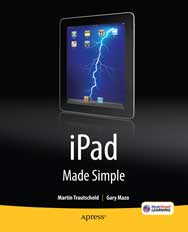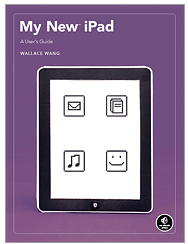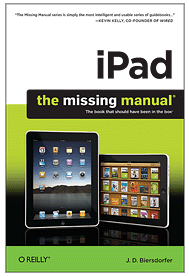Which iPad book is best for you?
Three iPad titles reviewed by guest writer Howard Nemerovski
iPad Made Simple
by Martin Trautschold and Gary Mazo
Apress
ISBN 978-1-4302-3129-5, 703 pages (all grayscale)
$29.99 US
My New iPad — A User’s Guide
by Wallace Wang
No Starch Press
ISBN 978-1-59327-275-3, 346 pages (all grayscale)
$24.95 US, $31.95 CN
iPad the missing manual
by J. D. Biersdorfer
O’Reilly / Pogue Press
ISBN 978-1-44938784-6, 299 pages (full color) plus missing CD
Our guest reviewer Howard Nemerovski explains why one of these three titles will serve you well as a guide to becoming a power iPadder. Take it away, Howard.
You can’t go wrong!
Who needs a book to learn about the iPad? Everyone who owns—or plans to own—one of those multi-functional beauties can benefit from reading any one of these books. I’ve owned my iPad since April, and every week, on my own, I have discovered more functions and opportunities. However, until I looked at these three books, it was hit and miss, and I was overlooking a ton of readily available fun and function.
Each book is well written, comprehensive, and helps the iPad user with familiarization, startup, installation and (except as indicated below for the Wang book) problem solving. More importantly, each book expands the reader’s horizon, enabling the user to take advantage of the remarkable resources available on the iPad and in the ever-expanding outside “iPad World.”
You’ll note my reference in the opening paragraph to the person who plans to own an iPad. With that person in mind, I think that it would have been useful (and certainly easy) to start each book with a short, dedicated and punchy analysis of the comparative utility of the various iPad configurations, i.e., number of gigabytes and the choice between Wi-Fi and 3G. Obviously each publisher (missing a chance to attract readers who want pre-purchase help) must have  concluded that the book purchaser already will have made that analysis and selected the specific iPad model. However, some  iPad shoppers might want some expert advice in advance of purchase, and they could benefit from a brief, targeted  discussion in the beginning of each book. For example, a Tip on page 32 of the Biersdorfer book acknowledges that the reader may not yet have purchased an iPad, and offers a too-brief discussion of the choice between Wi-Fi and 3G. Good try, but too little and too obscure!
This modest complaint, however, doesn’t detract from my appreciation of the value of each book to those of us who own iPads.
One distinction among the three books is that the Wang book’s index doesn’t have a Troubleshooting section, but the other two do. That section is very helpful, and its absence from the Wang book makes it a bit less helpful in solving problems.
Another distinction rests in the writing style: as is typical of the Missing Manual series, the Biersdorfer book is whimsical, funny and casual; the Wang book is open and informal; and the Trautschold book is more formal, but certainly still inviting and helpful.
The color images in the Biersdorfer book are much more attractive than the black, white and gray images in the other two books. The attractive page layout of the Biersdorfer book is consistent with the other Missing Manual titles, making that book more accessible. That compensates for the fact that the Biersdorfer book is shorter than the Wang book and is considerably shorter than the Trautschold/Mazo book. Obviously, Biersdorfer also is lighter and easier to carry, stash and peruse, and it certainly doesn’t sacrifice essential information.
Each chapter of each book begins with a very helpful summary, which assists in navigating the extensive text and gives the reader confidence that his or her issues will be addressed. The Wang and Biersdorfer book chapter headings are slightly easier to absorb than those in the Trautschold book.
I hope that these comments provide some preliminary help to the reader in evaluating these three valuable books. However, similar to Scott Willsey’s comments in his December 7, 2009 review of two iPhone books, it should be understood that the selection of one book among the three depends upon the personality, sophistication and needs of the reader. If the reader is technically oriented and seeks an encyclopedic compendium that is a bit formal, the 703 page iPad Made Simple by Martin Trautschold and Gary Mazo probably is the best choice, although its heft and dimensions dictate its probable permanent home on the reader’s desktop. In contrast, if  the reader is less wonky (or is perhaps age-challenged) and prefers a compact, portable manual with a layout and writing style that are more accessible and easier to navigate and absorb, the 299 page iPad the missing manual by J. D. Biersdorfer is the best choice. The 346 page My New iPad — A User’s Guide by Wallace Wang is a perfectly acceptable middle choice, marred only by its omission of a distinct troubleshooting section in the index.
There is a splendid digital edition of iPad Made Simple, including live links and color images. This digital book can be read on an iPad itself!
One thing is certain: the reader can’t go wrong in purchasing any of the three books. They all are valuable aids in exploring the remarkable virtues and features of the iPad.
MyMac Review Ratings, out of a possible 10:
Missing Manual — 10; iPad Made Simple — 10; My New iPad — 7
Note: The two 10 ratings should be understood in terms of the different mind sets of the users of the two books, as reflected by their distinct tone, graphics and length. Someone who would rate one a 10 might not rate the other a 10.



